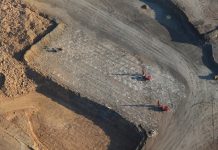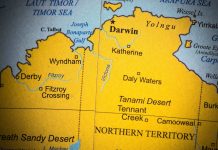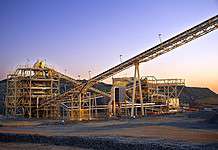Image: Glencore.
BY ELIZABETH FABRI
HOW can mining companies better plan for mine rehabilitation and restoration? It’s the million dollar question that has prompted a Federal Government inquiry into the matter.
Mine site rehabilitation practices across Australia are under more scrutiny than ever before.
In February 2017, the Federal Government launched an inquiry into the rehabilitation of resources projects. Once published, it will put a spotlight on current policies, safeguards – and of course – ways the industry can collaborate to improve what has become a contentious issue.
More than 90 submissions have been received to date from mining companies, industry groups, associations, and State and Territory Governments.
Many were of the view that current practices were not sufficient, with more clarity and direction needed to prevent the number of abandoned legacy mines – now a State liability – from growing further.
Society for Ecological Restoration Australasia (SERA) chair and Australian Research Council Centre for Mine Site Restoration director Professor Kingsley Dixon was one industry leader of this view.
“The industry has demonstrated that it lacks the ability to successfully and confidently restore post-mined landscapes,” Professor Dixon told The Australian Mining Review.
“More mines open than close leading to a growing cumulative impact and legacy for future governments to address.
“The ability to restore has not substantively improved for the bulk of the mining footprint in Australia.
“However there are industry who have strategically invested in R&D and are now achieving outcomes.
“Investment in R&D, either within the company or externally, is critical to climate-proof restoration in the future.”
Issues such as the cost of outstanding rehabilitation obligations, effectiveness of current Australian practices in safeguarding human health and the environment, and adequacy of financial mechanisms (State bonds and funds) were weighing heavily on industry and would be addressed in the inquiry.
A number of rehabilitation-focused industry bodies and organisations were also working towards strategies, including SERA; the Centre for Mined Land Rehabilitation; Minerals Council of Australia; and the Tom Farrell Institute, an environmental research and teaching arm at The University of Newcastle, which holds the annual Best Practice Ecological Rehabilitation of Mined Lands Conference in NSW.
Industry Feedback
Ahead of the inquiry’s close in October this year, the industry has sent lengthy submissions for consideration.
Minerals Council Australia (MCA) chief executive Tania Constable said the Council’s submission advocated a continued primary role by State and Territory Governments in the regulation of mine rehabilitation, closure and financial assurance.
“Each jurisdiction already has in place a mature regulatory framework for managing these matters,” Ms Constable said.
“Adding a further layer of regulation would result in additional complexity and potential duplication of effort for the industry, and is unlikely to deliver enhanced rehabilitation outcomes.”
Ms Constable said the Australian Government could contribute to improved rehabilitation and policy outcomes nationally through a variety of alternative approaches, including facilitation of dialogue between jurisdictions and industry to share knowledge, and the promotion of leading practice through the publication of relevant guidance.
Financial mechanisms
The effectiveness of current financial mechanisms across States and Territories was a highlighted issue.
The Tasmanian Government said security deposits were reviewed regularly, with tenement holders providing a description of the rehabilitation practices they intended to use to assist in setting an appropriate sum.
“The security deposit is only released when the minister administering the MRDA is satisfied that rehabilitation criteria have been met,” it stated.
Launched in 2006, the Northern Territory’s financial security requirement was designed to cover 100 per cent of the estimated costs of remediation.
However, the Territory faces potential issues with mines that were established before 2005.
“The Northern Territory has a number of legacy mine sites which, if unmanaged, pose long-term risk to the natural environment, as well as to public safety,” the Territory stated in its submission.
“Most legacy sites were created before 2005, and thus pre-dated the NT Government policy of requiring mining operators to lodge adequate financial security.
“As a result such mines have either inadequate or non-existent securities.”
SERA’s Mr Dixon said from his understanding the Australian bond system was “inadequate to meet a meet a minimum level of rehabilitation, let alone restoration”.
“Achieving the level of restoration aspired to in the National Standards will require substantially greater investment by industry that, in many cases will exceed their bonds by orders of magnitude,” he said.
MCA’s Ms Constable said financial assurance and provisioning was important, but a security bond did not remove a company’s obligation to rehabilitate land.
“Mine rehabilitation is highly regulated, better implemented and more accountable than ever before,” Ms Constable said.
“Each jurisdiction has in place regulatory safeguards – subject to periodic review – designed to mitigate the risk of operators avoiding their rehabilitation obligations.”
Effective Restoration
The Centre for Mine Site Restoration said there was also a problem of definition, with the term ‘restoration’ often incorrectly interchanged with ‘rehabilitation’.
The restoration process assists the recovery of an ecosystem that has been degraded, damaged or destroyed. Rehabilitation reinstates a level of ecosystem functionality on degraded sites – without necessarily reverting to an ecosystem’s pre-mining biodiversity.
The Centre said the technical capacity and science to achieve restoration for many Australian mine sites was “limited” which was a key constraint in achieving proven, cost-effective and scalable solutions in restoration.
“Although there are a handful of notable exceptions, it is clear that in Australia the majority of mining restoration projects are failing to deliver on the return of functional, representative, biodiverse and resilient ecosystems that are based on a suitable ‘reference community’,” the Centre said.
Reasons for this included inadequate biodiversity surveys; insufficient, inconsistent, and uncoordinated supply of high-quality genetically appropriate seed; lack of biological knowledge to maximise seedling; limited understanding of the physiology of plant establishment; and “critical shortage” of restoration researchers trained to overcome challenges in the resources sector.
“Currently, the costs of restoration are not being adequately determined prior to regulatory approval being granted,” the centre added.
“A full and complete understanding of the costs of restoration, which will vary markedly between landforms, operations and regions, must be determined and presented during initial mine planning and be included transparently as part of the approvals process.”
Native Title
Dr Rebecca Lawrence from the Macquarie University Department of Geography and Planning argued that Aboriginal Australians had more to lose from inadequate rehabilitation and closure practices than any other segment of the population.
“The majority of mining in Australia takes place on the Aboriginal estate and Traditional Owners, unlike many others involved in mining, do not leave when mines close,” Dr Lawrence said.
“They and their homelands will bear, in some cases for many generations, the costs of any failures in mine closure policy and regulation.”
Dr Lawrence also pointed to “troubling trends” documented in other submissions to the Inquiry, including asset transfers and mines being held indefinitely in “care and maintenance” as a way to avoid rehabilitation.
She recommended the Commonwealth lead a “complete overhaul” of State policy and legislation to ensure native title interests are fully recognised and protected, and support native title holders and claimants in negotiating native title agreements that deal comprehensively with mine closure, rehabilitation, and post-closure.
The Road Ahead
MCA’s Ms Constable said research innovation was key to improving rehabilitation outcomes.
“The Australian Coal Research Program (ACARP) is an example of collective industry effort to improve rehabilitation performance through innovative research,” Ms Constable said.
“Between 2007 and 2016 ACARP spent around $10 million on rehabilitation related research.
“The research program, while funded by the industry, is undertaken by independent researchers from government (CSIRO), universities (e.g. the University of Queensland, Central Queensland University) and private sector specialists.”
Mr Dixon said there was also some exciting new technologies in the pilot stages including creating synthetic topsoils; accelerating plant growth competency in post mined materials through use of the soil micro biome; seed pelleting and coating technologies; metabarcoding for rapid biodiversity assessment of pre and post-mined sites; and seed farming of native species, which was in its early stages.
Mr Dixon said seed farming of native species promises to deliver a social (Indigenous businesses), environmental (sourcing seed from sustainable managed sources) and reliable outcomes (through a supply of high quality seed to industry).
The use of remote sensing and drone technology was also facilitating new mapping and monitoring techniques, and rehabilitation practices such as turning open pit voids into pumped hydro practices were in the works.
“The role of pumped hydro as a post-mining land use needs to be determined on a case-by-case basis,” Ms Constable said.
“Mine altered landscapes and voids can have value and generate different land use opportunities.
“A pit or a pit lake may have future uses, including social (e.g. recreation), conservation (e.g. wetlands) or environmental and economic (e.g. Woodlawn bioreactor near New South Wales, and the pumped hydro energy park in Queensland).”
CASE STUDY: LATROBE VALLEY
 THREE open cut coal mines – Yallourn, Loy Yang and Hazelwood – in the Latrobe Valley are nearing, or are at, the end of their lives. Elizabeth Fabri spoke with newly appointed Latrobe Valley Mine Rehabilitation Commissioner Rae Mackay about the regional rehabilitation strategy currently in the works.
THREE open cut coal mines – Yallourn, Loy Yang and Hazelwood – in the Latrobe Valley are nearing, or are at, the end of their lives. Elizabeth Fabri spoke with newly appointed Latrobe Valley Mine Rehabilitation Commissioner Rae Mackay about the regional rehabilitation strategy currently in the works.
After 50 years of production, Victoria’s Hazelwood mine and adjoining power plant shut its doors in March 2017.
Hazelwood is one of three Latrobe Valley coal mines being examined as part of the Victorian Government’s $12.6 million Latrobe Valley Regional Rehabilitation Strategy (LVRRS).
The LVRRS is expected to be in full force by June 2020, with a preliminary submission due later this year.
Yallourn and Loy Yang – which can be mined until 2032 and 2048 respectively – are the other mines that make up the study, which will address some of the key knowledge gaps and the potential impacts of filling – either partially or fully—the mines voids with water to create pit lakes.
The strategy will be led by the Department of Economic Development, Jobs, Transport and Resources (DEDJTR) in partnership with Department of Environment, Land, Water and Planning (DELWP).
Latrobe Valley Mine Rehabilitation Commissioner Rae Mackay will provide independent advice directly to the Government, in consultation with local communities.
One year into from his appointment as Commissioner, and Mr Mackay had already attended about 150 meetings with local community groups, members, and Government officials.
“The challenge for the future is to ensure not only that the mines are safe, stable and sustainable for the long-term but that appropriate plans are in place for the rehabilitated land forms to be productive, attractive and add value to the region,” Mr Mackay said.
“For the year ahead, I will be working with my team on monitoring and evaluating the work of the LVRRS project team as they commence the extensive work of calculating the benefits and impacts of different rehabilitation scenarios; the planning activities of the three mines and in particular the work at Hazelwood mine, which is progressing detailed design work alongside its planning activities; the research program of the Integrated Mines Research Group; and, also the policy and programs of the various public sector organisations that will impact future mine rehabilitation.”
Mr Mackay said the role of Commissioner was valuable; one that could be “beneficially adopted on a wider basis” in other regions.
“I have found that the role offers stakeholders and the community tangible benefits by providing an appropriate sounding board for the outcomes of the work that is underway, and providing independent advice and support on areas of concern and possible contention,” he said.

























